




This free travel guide contains the first 3 days of our road trip of Malta, Gozo & Comino.




Curious for more? Buy the complete travel guide (pdf – 106 pages A4, easy to print or read on tablet) for the price of 1 Stuffat-tal-Fenek (Maltese rabbit stew), and explore all 3 islands with more extra walking tours, lots of practical information and tips by locals.


© travual.com | Buy the complete guide on shop.themediabay.be/en 2
Buy now on http://shop.travual.com/en

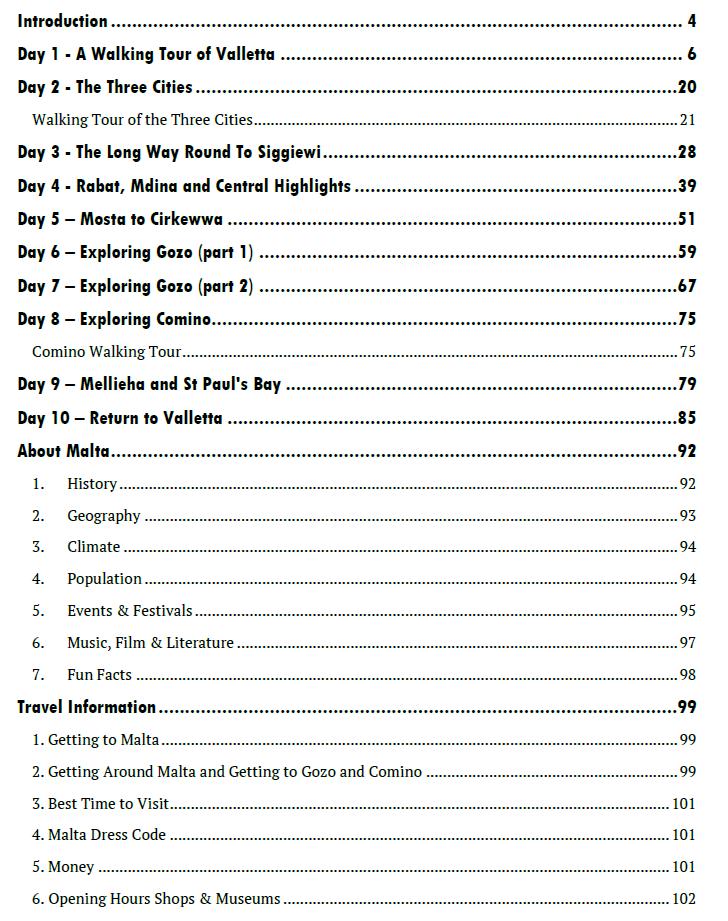
© travual.com | Buy the complete guide on shop.themediabay.be/en 3 CONTENT

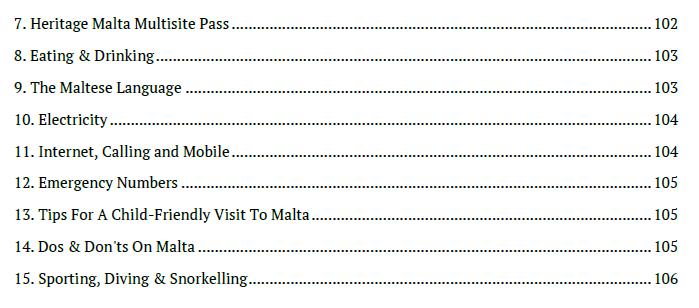
© travual.com | Buy the complete guide on shop.themediabay.be/en 4
INTRODUCTION
Malta is an island archipelago in the Mediterranean that holds more than its fair share of incredible historic sites and natural wonders. A visit here offers much, whether you are interested in megalithic temples or beautiful beaches, active adventure or the ultimate in relaxation. Old, young, and everyone in between will find plenty to admire.
The following guide is designed to give you a template to follow for a two-week visit to Malta. It will show you all the best known sites, as well as a range of less well known but equally enthralling attractions. It will show you the very best of Malta and will lead you also to the other two inhabited islands in the Maltese archipelago, Gozo and Comino. You will discover an intoxicating world of breathtaking natural sites and fascinating historic monuments, and you will be free to relax and unwind on these island paradises as we lead you by the hand from one moment of wonder to the next. You can simply enjoy your holiday, safe in the knowledge that you are in good hands and will not miss out on anything special.

In this guide, you will find suggestions for a ten-day driving or cycling itinerary around Malta along with information about potential side trips to her neighbouring isles. You may wish to extend the tour or shorten it. The good thing about this tour is that it is almost infinitely adaptable, so you can do one small section, an abbreviated version, or the whole thing, which is based on a two-week whistle-stop stay on the islands. The choice is yours. We present all the information, and you decide how you will use it. You can treat the tour as one complete journey and stay at different locations en route, or base yourself somewhere and head out to explore a different section each day.
In addition to this ten-day driving or cycling tour itinerary, you will find a raft of other useful information about Malta and Maltese culture, a guide to help you get to grips with a rich and intriguing country and its people and places. If you are someone who really likes to dive in and explore on your holidays, then this is the guide for you. Read on to discover more about your Maltese adventure.
While of course it is possible to see much of Malta by public transport, the easiest way to explore freely on your island holiday is to set your own agenda. That means hiring a car or a bicycle and having the ability to travel pretty much where you will, when you will. A car will of course allow you to travel a little faster, though it is worthwhile to consider the option of a cycle tour carefully, as this form of slow travel allows you to take more in, and of course allows you to enjoy a more eco-friendly holiday. Either by car or by bike, this ten-day tour will show you the very best of Malta, Gozo, and Comino. Enjoy a marvellous Mediterranean getaway!
• Total distance: 177 km
© travual.com | Buy the complete guide on shop.themediabay.be/en 5

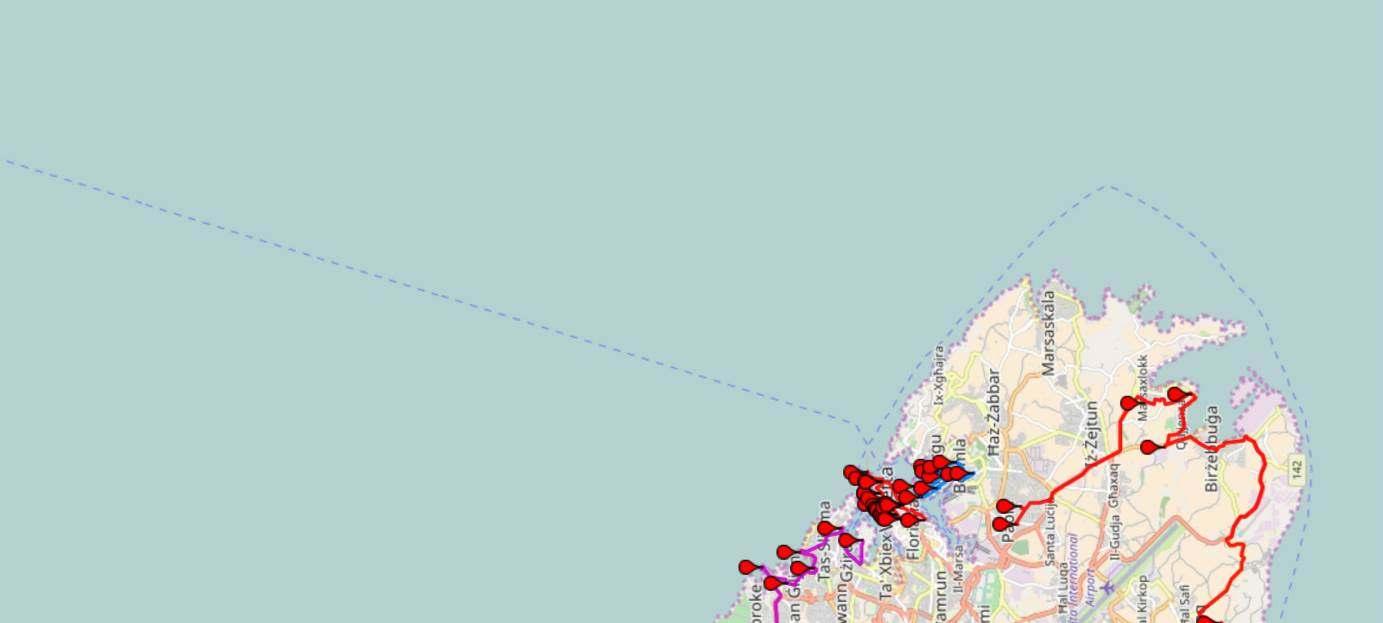
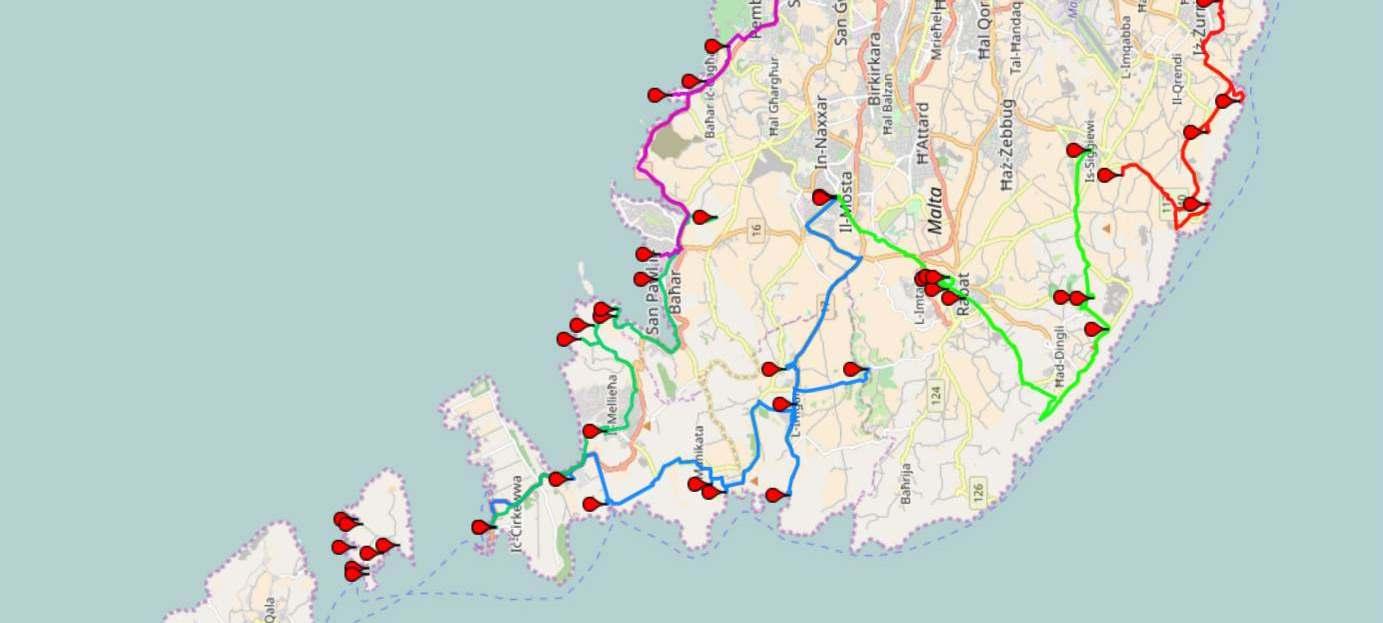
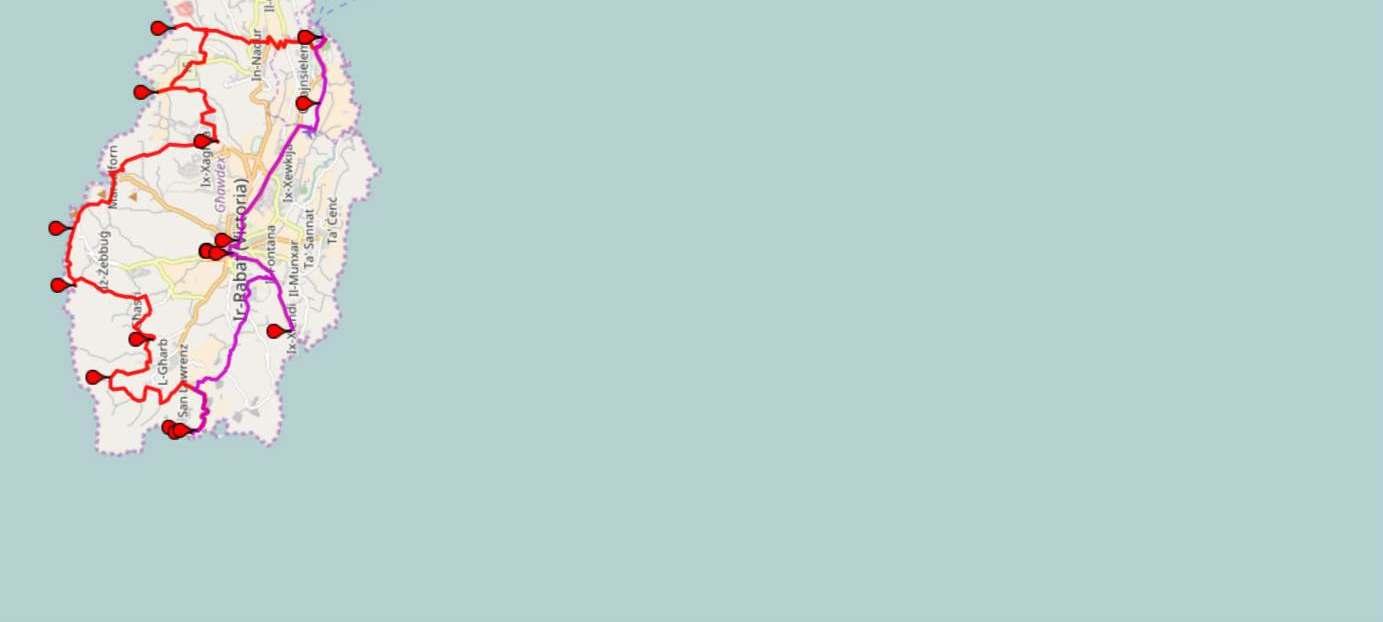



© travual.com | Buy the complete guide on shop.themediabay.be/en 6
DAY 1 - A WALKING TOUR OF VALLETTA
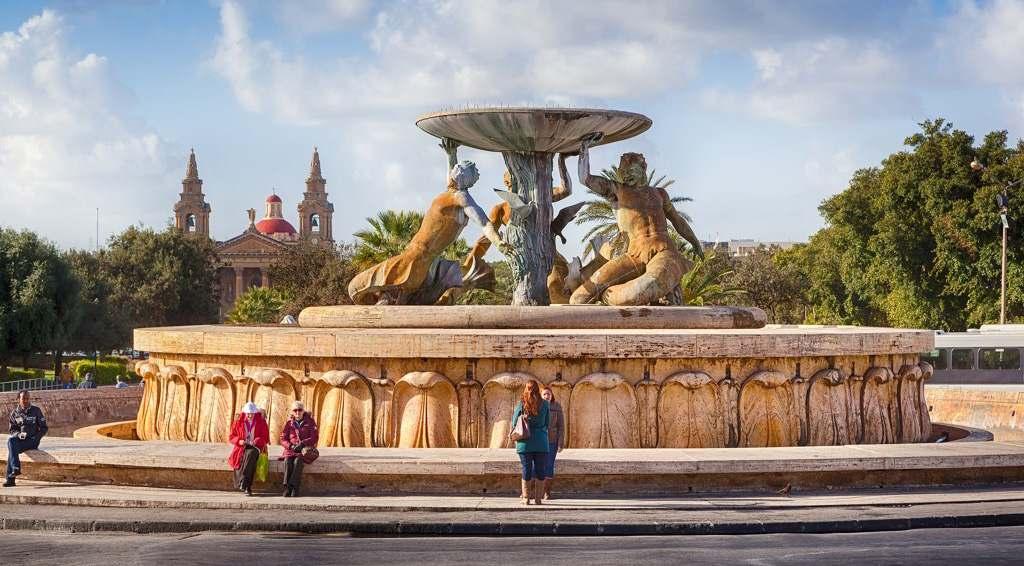
• Distance: 5.6 km

• Starting Point: Triton Fountain
• Finishing Point: Valletta Waterfront
The starting point of most visits to Malta is Valletta, the capital city of Malta and the southernmost capital city in Europe. This tiny city has an area of just 0.3 sq miles and so is very easy to explore on foot. And explore you should. The old city of Valletta is a UNESCO World Heritage Site with an intriguing history and culture. It has a range of streets and piazzas sporting architectural gems from mid 16th-century baroque buildings to modernist marvels.
The fascinating and historic city has much to offer, and you could easily spend a few days exploring all there is to see and do here. This walking tour of Valletta can be completed in a day, though you may wish to spread it out over a couple of days so that you will have longer to explore each site and museum on your route. Either way, you will find plenty of interest as you stroll Valletta's scenic streets. You will begin the tour at the Triton Fountain, a landmark that is very easy to find.
© travual.com | Buy the complete guide on shop.themediabay.be/en 7
Triton Fountain © Shutterstock
Lying just outside the main gate of Valletta, the bronze Triton Fountain was created by local sculptor, Vincent Apap, in 1959 and was installed to decorate the central bus terminus for the city. It is on the site of a 17th-century lunette (a structural fortification in a half-moon shape). Sadly, the original fortification was dismantled, and its ditch was filled in with rubble in the 19th century.
Triton Fountain, Vjal Nelson, Il-Belt Valletta // GPS: 35.89563°N, 14.50828°E
From the fountain, it is simply a case of walking across the bridge to the northeast. You will see the Main Gate to the City of Valletta in front of you; simply pass through that gate to begin your explorations. As you pass over the bridge, be sure to look down, and you will see remnants of the city's former fortifications.
The current Main Gate of Valletta is the fifth gate to stand on this site. This one was designed by Italian architect Renzo Piano and was built between 2011 and 2014. It is constructed of steel and limestone and is a bold statement for the entrance to the old city. The first gate to stand on this site was Porto San Giorgio, which was built in 1569. In about 1586 the gate’s name was changed to Porta Reale, and then the gate was rebuilt to in a different design in 1633. In 1853, the gate was replaced with a larger one, known as the Kingsgate. This was the last of the fortified gates to the city, and in 1964, it was demolished and replaced with a futurist gate, which was replaced in turn in 2011 by the latest design.
Renzo Piano Steps

Renzo Piano, the Italian architect, designed not only the gate itself, but he also redesigned the entire entrance to the city. As you pass through the gate, you will see wide, shallow staircases sweeping up either side. You can climb these flights of stairs to get some wonderful views out over the city.
Main Gate of Valletta, Valletta // GPS: 35.89623° N, 14.50925°E
As you pass through the main gate of Valletta, one of the first buildings you will see is the New Parliament Building.
© travual.com | Buy the complete guide on shop.themediabay.be/en 8
A B
The New Parliament Building is also part of Renzo Piano's design for the new entrance to the city. It is an innovative design that incorporates some interesting ecological features as well as a striking design. The building can generate 80% of the energy needed to heat it in the winter and 60% of the energy needed to cool it in the summer. However, this has been a divisive project, with opinions very much split. With this structure, you either love it or you hate it.
New Parliament House, Valletta // GPS: 35.89626°N, 14.50972°E // Most of building closed to public, for security reasons. Free entry to a permanent exhibition on the ground floor

As you pass through the gate and continue straight you will find yourself on Republic Street, with the Parliament Building to your right. You will now remain on Republic Street for much of the first half of this tour, all the way to Fort St Elmo, right at the tip of the peninsula on which the city sits sits. A number of the attractions you will be visiting are located along this thoroughfare, as are a number of cafés, bars, restaurants and shops where you can see to all your wants and needs during your stroll. After strolling along Republic Street for around 160 metres you will see the Church of Santa Barbara on your right.
A Roman Catholic Church, the Church of Santa Barbara was constructed to meet the spiritual needs of the Knights of Provence. The original church was built in 1573. It was restored in 1601 and completely rebuilt in 1739 in a baroque style. The baroque dome is typical of the period and yet is not seen on any other churches in the area. Today, this is still a parish church, offering services in English, French, and German along with a mass in Tagalog every Sunday and weekday masses in Maltese.
Church of St Barbara, Republic St, Valletta // GPS: 35.8970°N, 14.5107°E // See website for times of mass and service information. // http://thechurchinmalta.org/en/posts/1040/valletta-st-dominic
If you are interested in ecclesiastical architecture, then you can see another example just a few metres farther on, on the other side of Republic Street.
The original Church of Saint Francis of Assisi was constructed on this site between 1598 and 1607. This original structure was completely rebuilt in 1681 and was enlarged in the 1920s. Though it has been altered over the years, the church still contains much artwork of interest, along with a statue of St Francis.
© travual.com | Buy the complete guide on shop.themediabay.be/en 9
C D E
Church of St Francis of Assisi, Republic St, Valletta // GPS: 35.8973° N, 14.5108° E // Free to enter for worship and prayer

Continue just 30 metres or so past the Church of St Francis of Assisi, and you will see your next destination on your left.
The National Museum of Archaeology is often overlooked by those planning an itinerary in the city, but it really is one to pop into if you have the time. It is a treasure trove of archaeological wonders from the prehistoric era. Visiting this museum is a wonderful precursor to visiting Malta's famous temples later on. You can learn more about the people of the neolithic period and gain a better understanding of them through their tools, human and animal figurines, and temple artefacts.
National Museum of Archaeology, Republic Street, Valletta // GPS: 35.8974° N, 14.5111° E // See website for opening hours // Paid entry // http://heritagemalta.org/museums-sites/national-museum-of-archaeology/
After leaving the Museum of Archaeology, continue to walk in the same direction as you have been along Republic Street. Opposite the Law Court pillars you will find the visitor entrance of the St John’s Co-Cathedral. The main entrance is round the corner on Triq San Ġwann, but this entrance is the one used by visitors.

© travual.com | Buy the complete guide on shop.themediabay.be/en 10
F
Saint John Co Cathedral © Shutterstock
Dedicated to John the Baptist, Saint John’s Co-Cathedral was built by the Order of St John between 1572 and 1577. It had been commissioned by Grand Master Jean de la Cassiere as the Conventual Church of Saint John. The church was designed by a Maltese architect named Girolamo Cassar, whose work can also be seen on a number of other buildings around Valletta. The present interior was created in the 17th century by baroque artists such as Mattia Preti. In the oratory, you will find one of Caravaggio’s most famous paintings, “The Beheading of St John the Baptist”. Not to be missed, this is one of the finest examples of high baroque architecture found anywhere in Europe and is widely considered to be one of Europe's finest Cathedrals.
Saint John Co Cathedral, Triq San Ġwann, Il-Belt Valletta // GPS: 35.8976°N, 14.5125°E // See website for opening hours // Paid entry // https://www.stjohnscocathedral.com
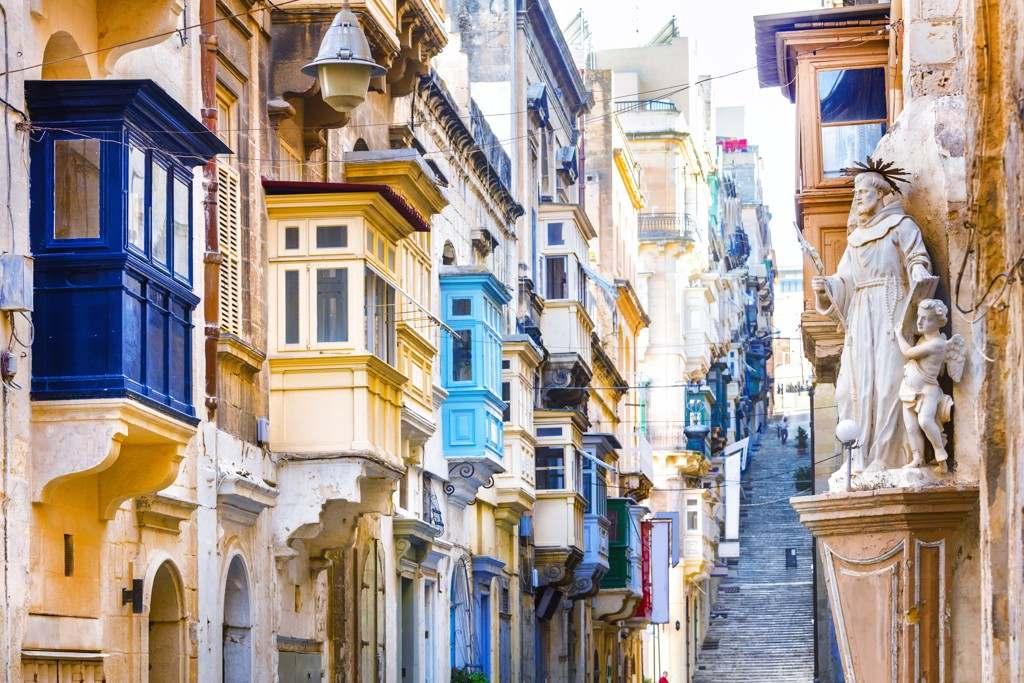
Turn right as you exit the Co-Cathedral opposite the large columns of the Malta Law Courts. After around 17 metres on Republic Street, you see a large square open up in front of you; you should turn left onto Old Theatre Street.

© travual.com | Buy the complete guide on shop.themediabay.be/en 11
G
Typical street in Valletta © Shutterstock
Old Theatre Street is named for your next destination but is something to see in and of itself. This back street is a charming place, narrow and bustling. It will give you a strong sense of the past and allow you to imagine travelling back through time. Theatre was once the preserve of the nobility, but in the 17th and early 18th centuries, things began to change, and the populace began to embrace this form of entertainment. Thus began Malta's long theatrical tradition, which still thrives to this day. Word to the wise—save some space for a bite to eat and visit Zero Sei, at 75 Old Theatre Street, which is one of the best places to eat in Valletta.
After approximately 140 metres on Old Theatre Street, you will see Teatru Manoel on your right.

Reputed to be the third oldest working theatre in Europe, Teatru Manoel is one of Valletta's most important performing arts venues. The theatre is named for the Grand Master of the Order of the Knights Hospitaller, Fra António Manoel de Vilhena, who ordered the construction of the building in 1731. This place is considered to be the national theatre of Malta and is the home of the wonderful Malta Philharmonic. The exterior of the theatre is in the mannerist style, while the ornate interior is rococo in style and retains many of its original features.If you get the chance to see a musical performance here, do not pass it up! Two water reservoirs beneath the floor create a breathtaking acoustic environment that is perfectly precise and clear as a bell. The rustle as the conductor turns the pages of a score can be clearly heard throughout the auditorium.
Retrace your steps down Old Theatre Street to rejoin Republic Street once more. You will see the Palace of the Grandmaster and the Armouries Museum on the other side of St George's Square.
Valletta's largest and most magnificent square, St George's Square, also known as Palace Square, is right at the heart of the city and is the focal point for many of the city's major events. The square is flanked on all sides by grand and impressive buildings. One is the famous Palace of the Grandmaster, which stands on the southeast side of the square on Republic Street. Impressive baroque buildings stand on the other three sides. To the southwest is a palace formerly known as Casa del Commun Tesoro (House of the National Treasury). To the northwest is the Main Guard Building and to the northeast is the Hostel de Verdelin, sometimes known as the 'house of the doves' on account of the ornate carvings on its facade.
©
| Buy the
12
travual.com
complete guide on shop.themediabay.be/en
N, 14.5124° E
Teatru Manoel, Old Theatre Street, Il-Belt Valletta // GPS: 35.8998°
// See website for forthcoming events // Paid performances // www.teatrumanoel.com.mt
H
ISince the inauguration of the city of Valletta, the Grandmaster's Palace has been the seat of Government of the Maltese Islands. When the French were ousted from the island, it became the British Governor's Palace and later it became the Palace of the President of Malta. It was in 1571 that Grandmaster Pietro del Monte saw the site and ordered a palace to be built there. He died soon after, however, so it was during the reign of the next Grandmaster, Jean de la Cassiere, that the palace was actually built to the designs of architect Gerolamo Cassar. Later grandmasters redecorated, enlarged and embellished the original structure, turning it into the grand and majestic building that we see now.
Today the building has multiple state rooms to visit, and there is also an armouries museum. There are many grand, unique, and fascinating items to see.

The Grandmaster's Palace, St George's Square, Il-Belt Valletta // GPS: 35.89861°N, 14.51417°E // For opening hours see website. These may change at short notice due to the exigencies of the Office of the President // Paid entry – two tickets required for state rooms and armoury.// http://heritagemalta.org/museums-sites/the-palace-state-rooms
Once you have taken some time to look around the museums, turn right onto St George's Square and continue on Republic Street. After about 160 metres you will find your next destination on your right.

© travual.com | Buy the complete guide on shop.themediabay.be/en 13
Grandmaster’s Palace © Shutterstock
The Casa Rocca Piccola was built during the era of the Knights of St John in 1580. Such palaces were built for prestige and aesthetic beauty and helped to make Valletta a capital to rival Paris or Venice. Casa Rocca Piccola was one of two houses built in Valletta by Admiral Don Pietro la Rocca. At the time of its construction, it became known as “the house with the garden”, as houses in Valletta were not normally allowed to have gardens. The house is grand, with over fifty rooms, including two libraries, two dining rooms, many drawing rooms and a chapel. Today, many of its splendours may still be seen, including the largest private collection of Maltese lace found anywhere.
Casa Rocca Piccola, 74 Republic St, Valletta // GPS: 35.89983°N, 14.51527°E // Open 10 am – 4 pm except Sundays and public holidays // Paid entry, under 14s free // www.casaroccapiccola.com/plan-visit/
Continue along Republic Street, and after 180 metres, turn right onto North Street. Remain on North Street for just under 200 metres, and then turn left onto Mediterranean Street. Cross the street and make your way north to Fort St Elmo.
Fort St Elmo stands guard on the end of the Sciberras Pensinsula and keeps watch over both the Grand Harbour and the Marsamxett Harbour. This is a strategic position that has been recognised and exploited since the Middle Ages. There were fortifications of various sorts here before this fort was constructed in the mid 16th century. The Order of St John's victory over Ottoman forces, who first attacked the fort in 1565, led to the reconstruction and enlargement of the fort and the contruction of the fortified city—Valletta. The architect of the new and improved fort, Francesco Laparelli, was also responsible for the design of the new city’s gridiron street plan. The fort has been further enhanced, amended, altered and improved over the centuries and played a key role in many conflicts, up to and including the Second World War. The fort now plays host to the National War Museum of Malta
Fort St Elmo, Valletta, Malta // GPS: 35.90209°N, 14.51856°E // See website for opening hours // Paid entry // http://heritagemalta.org/museums-sites/national-war-museum
Retrace your steps out of the museum and take the stairs to your left. You will find that by following the outer walls, you can walk round the end of the peninsula outside the fortifications. Following the St Elmo Bridge will allow you to reach the Breakwater Bridge. Note, however, that while beautiful, this route is rugged in places and has many steps as it makes its way round the rocky coastline.

© travual.com | Buy the complete guide on shop.themediabay.be/en 14
J K
Breakwater Bridge, inaugurated in 2012, was built as a symbol of the city's regeneration efforts to replace the original bridge, which was partially destroyed by an Italian attack during the Second World War and then removed entirely after the war. The bridge links Fort St Elmo to the north breakwater arm and is similar in design to the original, though with a single span instead of two. The new bridge was built on top of the original pillars, which had remained since the original bridge's removal. The bridge is open to the public, though caution is strongly advised as the conditions can be extreme here on occasion. Standing on the bridge can give an interesting and different perspective on the city.
Retrace your steps, and if you wish, you can enter the Malta Experience, close by the steps that you descended to reach the pathway round the end of the peninsula.
The Malta Experience is a visual attraction that brings to life the 7,000 year history of Malta and its people. This tourist attraction is housed in a purpose-built auditorium and has welcomed over four and a half million visitors since it opened in the 1980s. The show and technology are updated regularly to stay fresh and current. For those interested in an overview of the country's history, this could be a good option.
The Malta Experience, St Elmo Bastions, Mediterranean Street // GPS: 35.8998°N, 14.5186°E // See website for show times and opening hours // Paid entry // www.themaltaexperience.com
Exit and turn left onto Mediterranean Street. Your next destination will be on your right in around 70 metres.

The Sacra Infermeria (Mediterranean Conference Centre) & Knights Hospitallers Museum was originally built in the 16th century as a hospital. It was constructed by the Order of St John and was their Sacra Infermeria (Holy Infirmary). Until the 18th century, this was one of the foremost hospitals in Europe. It received Maltese patients and patients from abroad and was was also originally used to lodge pilgrims travelling to the Holy Land. The hospital was in use until after the end of the First World War. Within the old Sacra Infermeria, you will find a series of displays about the Knights Hospitallers.
Mediterranean Conference Centre, Mediterranean Street, Valletta // GPS: 35.89943°N, 14.51818°E // Paid entry // See website for opening hours // www.mcc.com.mt
15
© travual.com | Buy the complete guide on shop.themediabay.be/en
L M N
Walk south on Mediterranean Street for 140 metres and then take a slight right onto Lvant. After 450 metres, take the pedestrian overpass and climb the stairs. Turn right at Mediterranean Bank and continue onto Triq Il- Batterija, and ahead of you, you will find the entrance to the War Rooms Museum and NATO tunnels.

The incredible Lascaris War Rooms consist of an underground complex of tunnels and rooms that housed the HQ for defence of the island during the Second World War. The British created this underground complex, beginning this secret work in 1940 and finishing in early 1943. The work expanded a series of tunnels that had been used as slave quarters during the Hospitaller period. After the war, the site became the HQ of the Royal Navy's Mediterranean Fleet, which played an active role during conflict periods, including the Suez Crisis and the Cuban Missile Crisis. For ten years from 1967, NATO used this site as their headquarters for the interception of Soviet submarines in the Mediterranean.
Head northwest and then turn left into Triq Il-Batterija and left again onto Triq Sant’ Orsla. You will find your next destination on your left.

© travual.com | Buy the complete guide on shop.themediabay.be/en 16
Lacaris War Rooms © Shutterstock
Lascaris War Rooms, Valletta // GPS: 35.8949°N, 14.5128°E // See website for opening hours // Paid entry // www.lascariswarrooms.com
O
The Upper Barrakka Gardens give a beautiful overview of Grand Harbour and the three cities beyond. They are a pleasant place to take a stroll and enjoy the peaceful surroundings. The gardens are situated on the upper tier of the Sts Peter and Paul Bastion, which was built in the 1560s. The garden features terraced arches, which were built in 1661 by the Italian knight Fra Flaminio Balbiani. Originally, there would have been a roof above these arches, though this was removed after the Rising of the Priests in 1775.
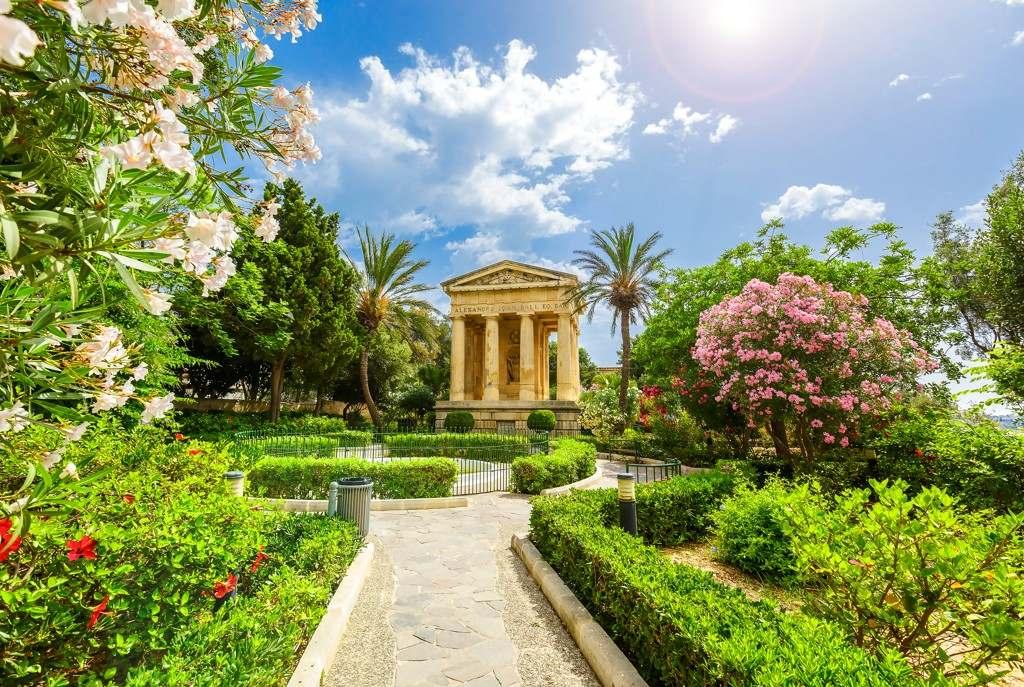
Walk out of the gardens and straight on to Castille Street. At the end of the street you will turn right onto Triq San Pawl and will see the next destination on your right.
The grand Auberge de Castille was originally constructed in the 1570s to house knights of the Order of St John from Castile, Leon and Portugal. The building currently on the site dates from the 1740s. It is a replacement for the original building that was

© travual.com | Buy the complete guide on shop.themediabay.be/en 17
Upper Barrakka Gardens, Triq Sant' Orsla, Il-Belt Valletta // GPS: 35.89472°N, 14.51222°E // Open 7 am to 10 pm // Free entry
Upper Barakka Gardens © Shutterstock
P Q
constructed during the magistry of Manuel Pinto da Fonseca. In an independent Malta, this baroque building is the office of the Prime Minister. Unfortunately, it is not possible to see the interior, but it is worth the detour to look at the impressive facade.
Return now to the Upper Barrakka Gardens to take the spectacular Barrakka Lift, which carries people between the Upper City and Grand Harbour down below. The lift is 58 metres high and offers quite an experience as well as a good way to descend to the waterfront. There is a fee to pay for use of the lift, though it is worth noting that you could combine this with a ferry ticket to the three cities (see your options for travel on day two of your Maltese tour).
Once you have taken the lift and made your way to the waterside, it will take only eight minutes or so to head southwest on Xatt Lascaris to Valletta Waterfront, actually located outside of Valletta in neighbouring Floriana.
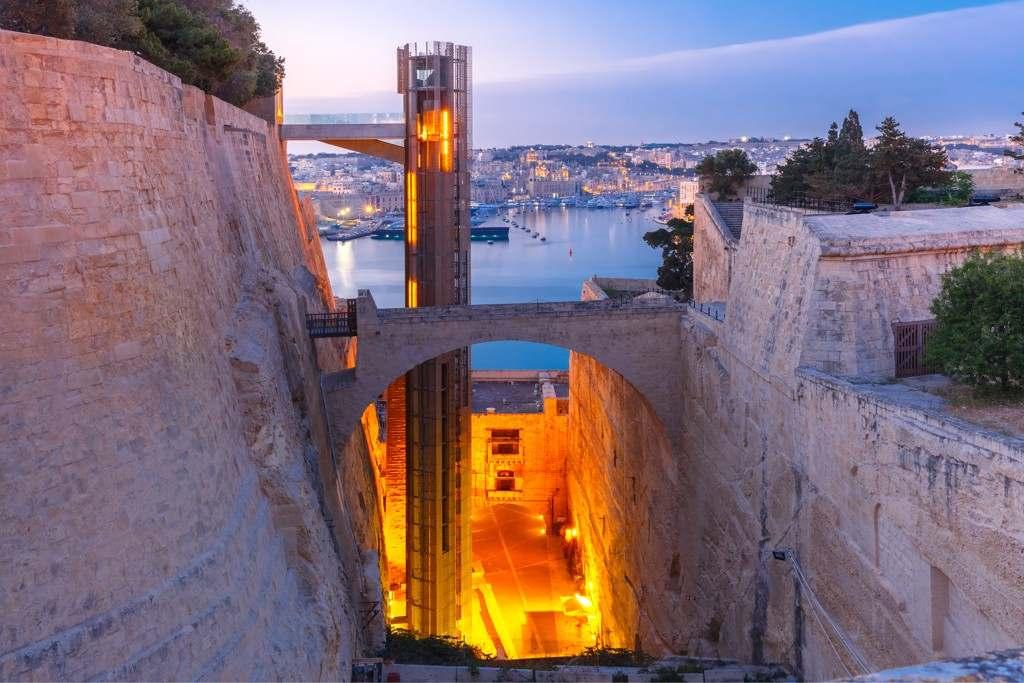

© travual.com | Buy the complete guide on shop.themediabay.be/en 18
Auberge de Castille, Valletta Il-Belt // GPS: 35.8958°N, 14.5114°E
Barakka Lift © Shutterstock
The grand Valletta Waterfront was developed by Grandmaster Manuel Pinto de Fonseca in 1752 and features a number of baroque-style buildings, most notable of which are a church at the centre, the Pinto Stores and Pinto Wharf to the left, and the Forni Stores on the right. These stores and warehouses were designed by Andrea Belli. As well as being of historic interest, Valletta Waterfront is also a bustling cruise terminal and has a great many restaurants, bars and shops to explore, as well as a number of entertainment options.

Perhaps this could be the perfect place to relax and unwind after your day exploring Valletta and a good place to fortify yourself for further explorations.

© travual.com | Buy the complete guide on shop.themediabay.be/en 19
R
for a hotel in Valletta? Click here for special offers.
Valletta Waterfront © Shutterstock
Looking

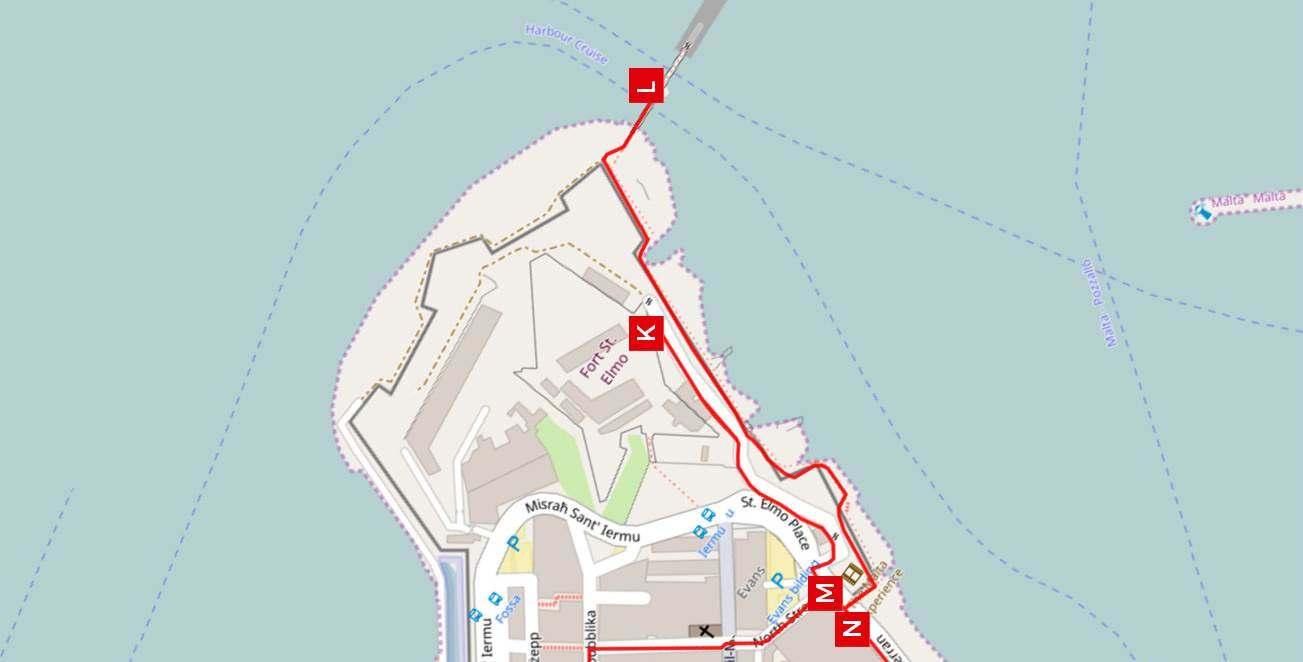
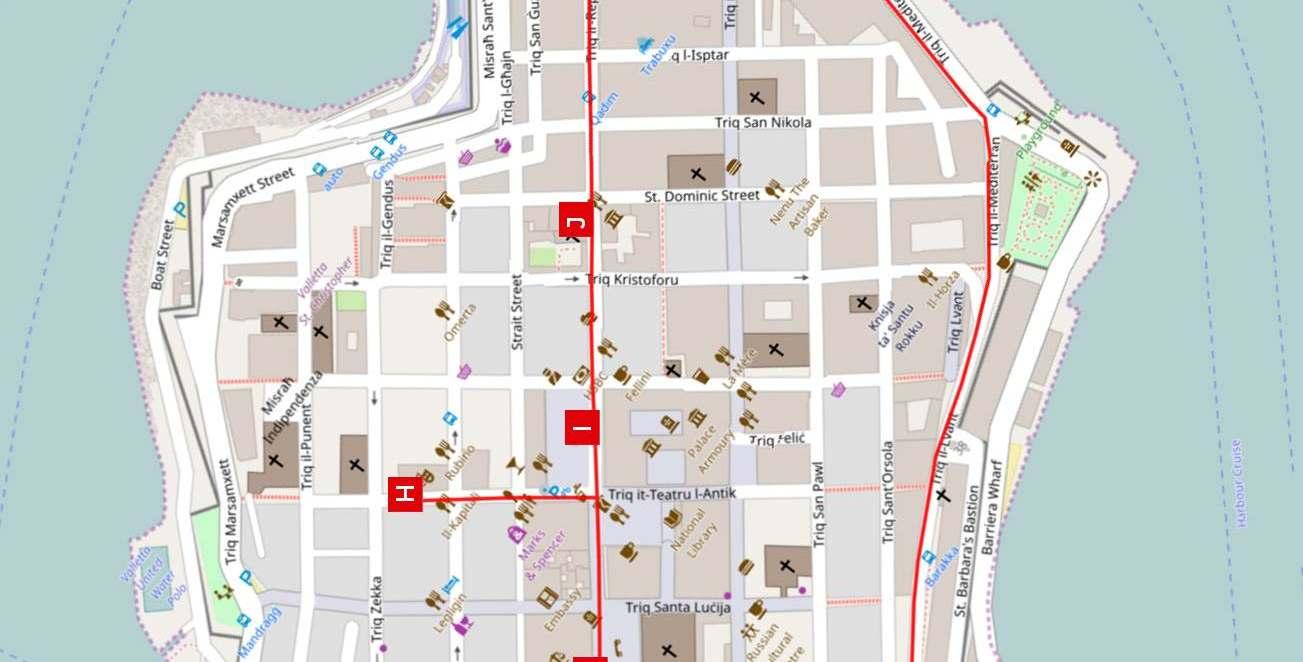
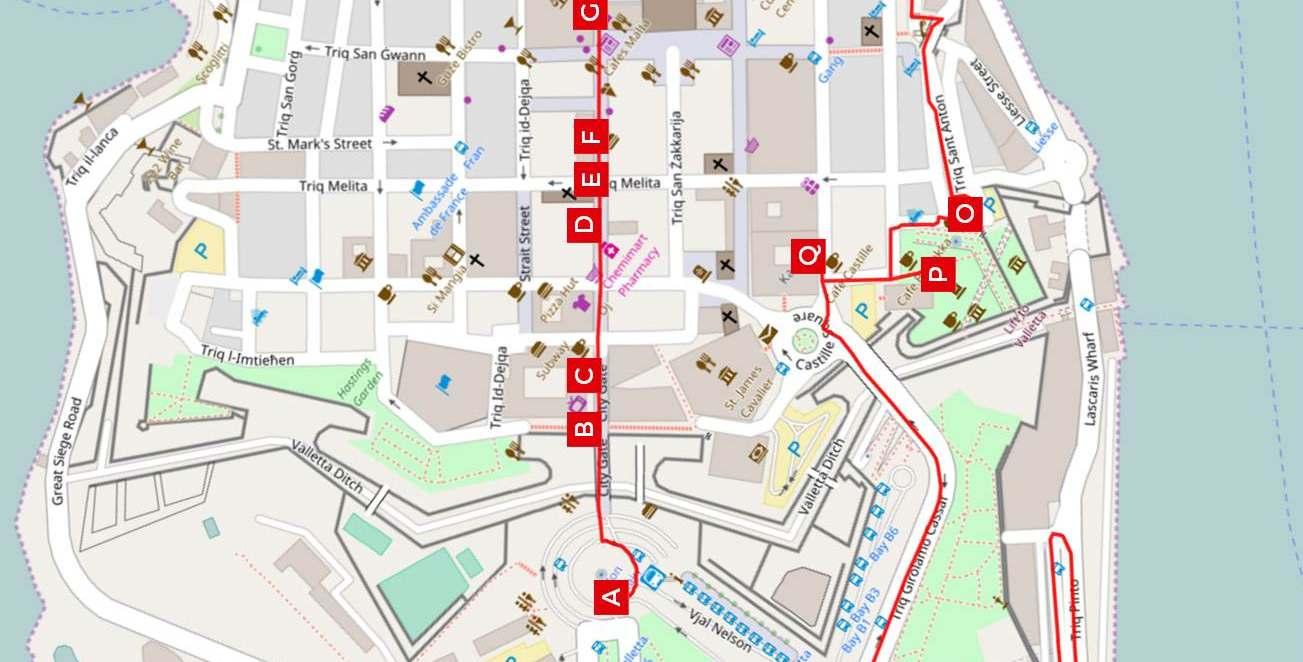
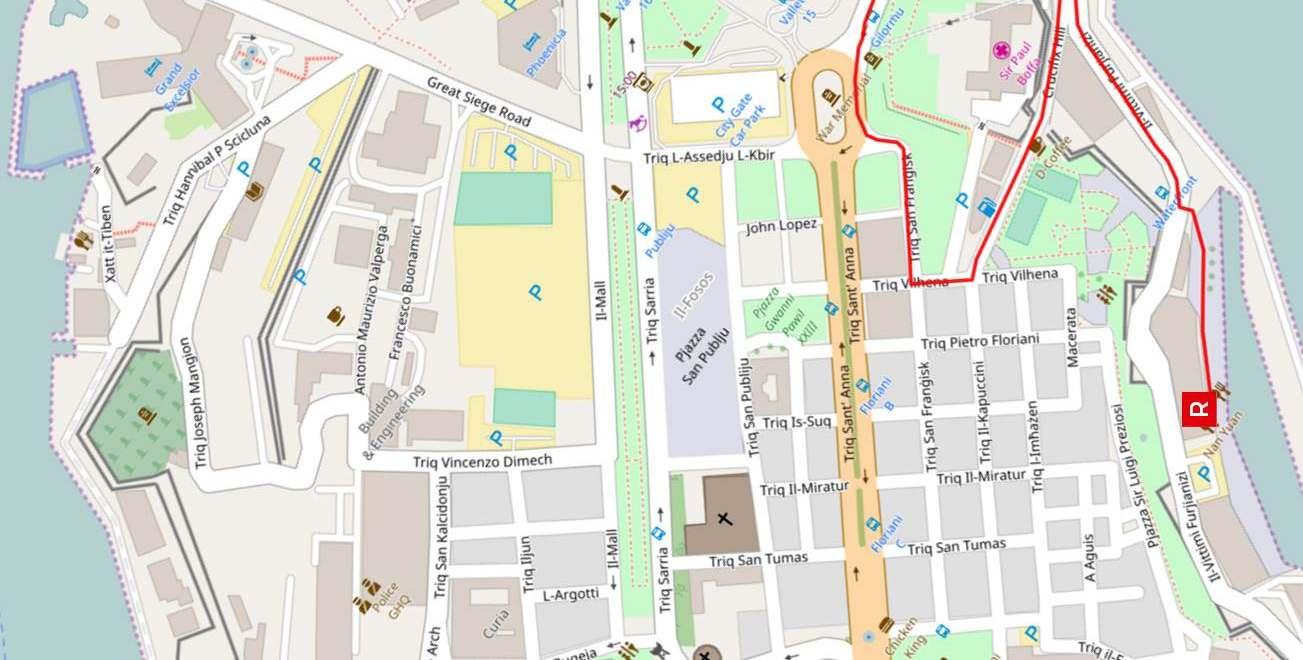
© travual.com | Buy the complete guide on shop.themediabay.be/en 20
DAY 2 - THE THREE CITIES
The three cities is the name collectively given to the fortified settlements of Vittoriosa (Birgu), Senglea (L-Isla) and Cospicua (Bormia). Of these three cities, Vittoriosa, also called Birgu, is the oldest, having been founded in the Middle Ages. The other two were founded by the Order of St John in the 16th and 17th centuries. These settlements lie on the other side of the Grand Harbour from Valletta. They are far less frequently visited than Valletta and other headline attractions on Malta, and yet they give both a fascinating glimpse into authentic Maltese life and a window of Malta's long and diverse maritime history.

There are several options for your visit to the three cities. The first is to simply get in your hire car or bicycle and drive or ride to the three cities as you begin your clockwise tour around the island of Malta. Traffic can be a little heavy during the busiest summer months, though it is usually relatively straightforward to find parking within easy walking distance of the main sites and attractions of the three cities.
Another option is to delay hiring a car until day three and to make your way to the three cities from Valletta, either by bus or in one of the water taxis that will carry you across the Grand Harbour. To find out more about these water taxis, Maltese Dgħajsa, visit www.maltesewatertaxis.com. If you decide to visit without a car, or even if you do have one, it is relatively easy to enjoy a walking tour of the main attractions, which you will find below. If, however, you do wish to forgo the strain and take life a little easier, then an audio tour in an electric car could be a good option. Visit www.rollinggeeks.com to find out more.
If driving from Valletta, reaching Cospicua will take only around 12 minutes, and you will have covered a distance of only 6-7 km. Basically, you are just skirting the defences around the edge of the Grand Harbour. The fastest route (from Valletta Waterfront) is via Triq Dicembru 13. At the roundabout, take the first exit onto Triq Alto Moro then, in Albert, continue onto Triq Il Labour. After around 400 metres, veer slightly left onto Vjal Sir Paul Boffa, then at the roundabout, take the second exit onto Corradino Road, taking another second exit at the next roundabout onto Triq Ghajn Dwieli. Continue onto Triq It-Tlett Ibliet and then onto Triq San Frangisk. Now you are within walking distance of the main attractions, and it is simply a question of finding a parking space and setting off to explore on foot once more.
As you make your way into the Three Cities, you cannot fail to notice the grand fortifications that surround them. These are the Cottonera Lines and the older Santa Margarita Lines, which were built in the 17th and 18th centuries to protect the three cities.
© travual.com | Buy the complete guide on shop.themediabay.be/en 21
Walking Tour of the Three Cities
• Distance: 5.2 km
• Starting Point: St Helen’s Gate
• Finishing Point: Fort Saint Angelo
This walking tour will allow you to cover some ground in the Three Cities and experience the real life of the streets as you make your way between the highlighted attractions. The whole walk covers around 5 km and will take just over an hour's walking time. You will want, however, to take your time and get to know the maze-like tangle that lies within the fortifications. If you arrive by boat to Birgu, you will likely want to do this tour in reverse.
A natural starting point for exploration of the three cities if you have arrived by car or bus is St Helen's Gate.
Also known as Porta dei Mortari, St Helen’s Gate is the main gate of the Santa Margherita Lines, major defensive structures of the three cities. These lines were built in the 17th and 18th centuries to protect the cities from invasion by land. This gate was constructed in 1736. It was built to the designs of Charles Francois de Mondion and served as the main gate to the city of Conspicua, also known as Bormla.
A B

Walk north through Cospicua on Triq I-Inkurunazzjoni. After around 170 metres, continue onto Triq Fuq San Pawl, which veers slightly right after 110 metres and becomes San Pawl. After a further 210 metres, take a slight left onto Triq Il-Vitorja. Take a slight left at St Michael Bastion to stay on the same road as you enter the next of the three cities, Senglea, and you will find your destination on the left after around 180 metres.
The Roman Catholic Church Senglea Basilica is one of the landmarks in Senglea. It is dedicated to the nativity of the Virgin Mary and is another of the many examples of imposing baroque architecture in Malta. The original building here was probably built in 1580 and was consecrated in 1743. Sadly, this structure was destroyed during the Second World War but was rebuilt in 1956. Within the grand interior, one piece of artwork is particularly revered. This is a wooden statue of Mary, known as Il-Bambina. It was carved in 1618 and then painted
22
© travual.com | Buy the complete guide on shop.themediabay.be/en
St Helen's Gate, Triq Santa Liena, Bormla // GPS: 35.87926°N, 14.52075°E
and gilded in 1631. The sculptor of the work is unknown. There are also a number of other artworks to see.
Senglea Basilica, Senglea, Malta // GPS: 35.8857°N, 14.5181°E // http://thechurchinmalta.org/en/posts/918/senglea-lisla

Continue north through Senglea to the northernmost tip, where you will find your next destination.
The Gardjola Gardens overlook the Grand Harbour, offering grand and inspiring views back towards the city of Valletta. Within the gardens you will find an ancient guard tower called Il-Gardjola, which long guarded the harbour from enemies. The gardens were constructed in a grid pattern on the orders of Grandmaster De La Sengle in 1551. Look out for the symbols on Il-Gardjola—an eye, an ear and the crane bird—all symbols of the watchfulness of the sentry post.
Gardjola Gardens, Senglea // GPS: 35.8906°N, 14.5141°E
On your way back down the peninsula on which sits the city of Senglea, stick to the east, looking over towards your destination later on this tour—Vittoriosa (Birgu). En route back to Cospicua you will see this other section of the fortifications.
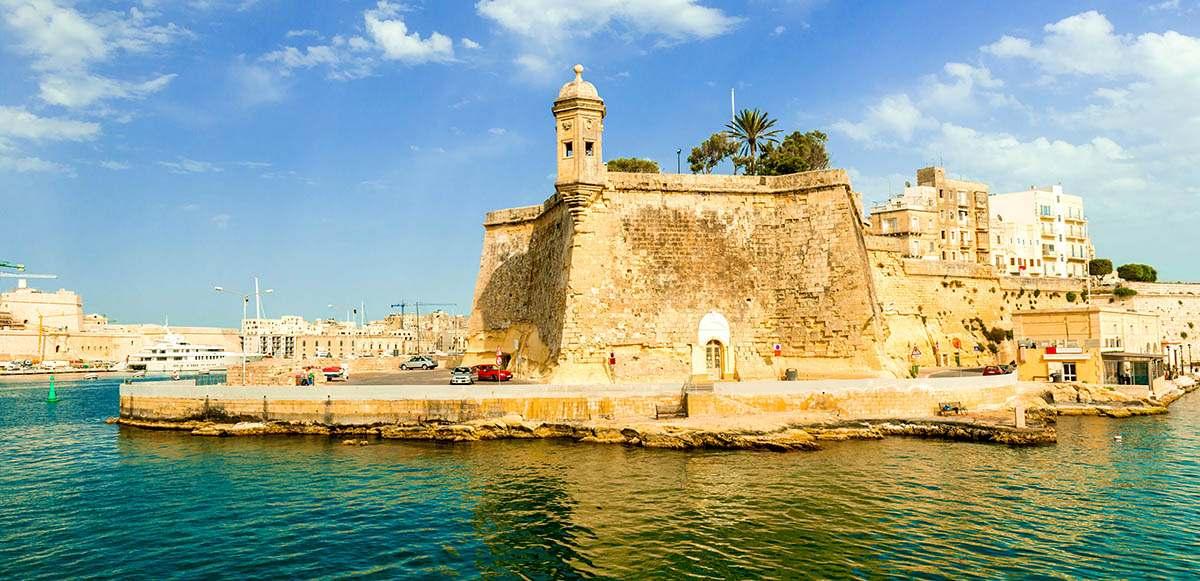
© travual.com | Buy the complete guide on shop.themediabay.be/en 23
Watchtower and Gardjola Gardens © Shutterstock
C
Il-Macina is one of the most spectacular of the remaining sections of Senglea's fortifications, many of which were destroyed during the 19th and 20th centuries. IlMacina, also known as Sheer Bastion, is a wedge shaped bastion in Dockyard Creek. It was built in 1554 by military engineer Bellavante. A machine used to mount masts in ships was once affixed to the top of the rampart of this building, and this was where it got the name “IlMacina”.
Sheer Bastion, Senglea // GPS: 35.88552°N, 14.52009°E
Walk south and rejoin Triq Il-Vitorja, retracing your steps and then taking a left onto IX-Xatt Ta Bormila, right onto Triq L. Jun and then left and left again onto Triq Il-Pellegrinaag. Take the stairs, and the destination will be on your right.

The Collegiate Church of the Immaculate Conception in Cospicua was finished in about 1730. The present structure replaced a smaller structure that was built before the Great Siege of Malta in 1565. The building as it stands is said to have been designed by Vincenzo Casanova, while the bell towers are attributed to Lorenzo Gafà. The Feast of the Immaculate Conception is celebrated in Cospicua in December each year.
Immaculate Conception Church, Cospicua // GPS: 35.88124°N, 14.52069°E // See website for hours and services // http://thechurchinmalta.org/en/posts/240/cospicua
Walk northeast on Triq Il-Pellegrinaag then veer right towards Marija, taking the stairs. Turn right onto Marija. After 70 metres or so, turn left onto Triq San Gorg an then after 35 metres, right onto Grima. After almost 50 metres, turn left, and your destination will be on your left.
The Bir Mula Heritage Museum is a little gem that is somewhat off the beaten tourist trail. It may look ordinary from the outside, but inside it is far from commonplace and well worth taking the time to visit. It is a treasure trove of Bormla (Cospicua) homes through the ages and tells many fascinating stories of history, legend, secret plots and conspiracies. It would be a shame for anyone with an interest in Maltese cultural history to miss out on a visit to this hidden jewel on one of Cospicua's five hills.
Bir Mula Heritage Museum, 79, St Margaret Street, Bormla // GPS: 35.8831°N, 14.5236°E // See website for opening hours and news of exhibitions and events // www.birmula.com
© travual.com | Buy the complete guide on shop.themediabay.be/en 24
D E F
Head north for around 130 metres and then, when you see the playground ahead of you, turn left and then right to cross the staggered junction and keep making your way north through the park to your left. There are some busy roads, so take care as you cross on the zebra crossing. The War Museum will now be in front of you.
The Birgu (Vittoriosa) Malta at War Museum is dedicated to telling the story of the important role played by Malta and its people during the Second World War. Exhibits are housed in an old barracks and an air-raid shelter in the rock within the Couvre Porte Counterguard. There are a number of fascinating artefacts on display that will enlighten you about this period in the country's history and European history.
Malta at War Museum, Birgu // GPS: 35.8854°N, 14.5225°E // See website for opening hours // Paid entry // www.maltaatwarmuseum.com

Exit the museum onto Triq P. Boffa and turn left, continuing north. After around 170 metres you will reach the next stop on this tour.
In the early modern period, palaces like these would have been seen all over Europe and South America, but now this Inquisitor's Palace at the heart of Birgu/ Vittoriosa is one of the few remaining examples and the only Inquisitor's Palace in the world that is open to the public. It is an architectural gem whose survival has been ensured by the important men who have occupied it over its five hundred year history. This was the seat of the Maltese Inquisition between 1574 and 1798 and sheds some light on this period in the country's chequered history.
Inquisitor's Palace, Birgu // GPS: 35.8872°N, 14.5225°E // See website for opening hours // Paid entry // heritagemalta.org/museums-sites/the-inquisitors-palace
Turn right and continue on Triq P. Boffa until you reach the Main Square of Birgu. Turn left onto Nestu Laiviera and then left again after around 100 metres. You will see the church on your left.
Birgu/Vittoriosa is one of the oldest parishes in Malta. The St Lawrence Church was built between 1681 and 1697 to the designs of architect Lorenzo Gafà. It is a fine example of the Roman baroque style of architecture and has an impressive, ornate interior with statues, paintings and a marble Latin cross. This was the conventual church for the Order of St
© travual.com | Buy the complete guide on shop.themediabay.be/en 25
G H I
John before the co-cathedral was built in Valletta. A small yet perfectly formed and interesting museum is also located next to this parish church. The festa here is celebrated annually on the 10th of August.

From here it is simply a case of strolling ahead of you down to the marina, then turning right and making your way up along the waterfront to the end of the peninsula.

© travual.com | Buy the complete guide on shop.themediabay.be/en 26
St Lawrence Church, Birgu // GPS: 35.8873°N, 14.5214°E // Open Mon-Sat 7 am-6 pm // www.malta.com/en/attraction/culture/church/st-lawrence-church
St. Lawrence's Church in Valletta © Shutterstock
Built, it is said, on the site of a fortified Roman settlement, Fort Saint Angelo is amongst the most impressive features of Malta's military architecture. When the Knights of St John arrived on the island in 1530, they made the fort the seat of the Grand Master of the Order. Against all the odds, this fort managed to repel a formidable Saracen armada during the Great Siege of 1565. The events of the Great Siege gave this place its legendary status. Today, you can learn more of the building's role in Malta's military history at the fascinating museum, and of course enjoy breathtaking panoramic views of the Grand Harbour.
Fort Saint Angelo, Birgu Waterfront, Birgu // GPS: 35.8925°N, 14.5178°E // See website for opening hours // Paid entry // http://heritagemalta.org/museums-sites/fort-st-angelo/
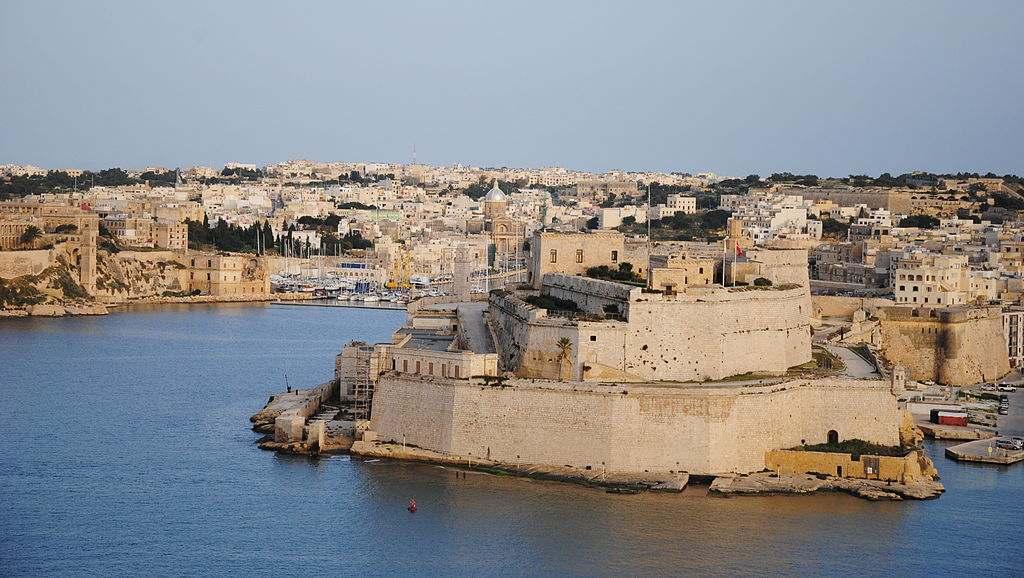
Of course, there is plenty more to see and do in the three cities, but the above tour should allow you to get an overall sense of the lay of the land on this side of the Grand Harbour before you return to Valletta or continue on your driving tour of Malta.
Looking

© travual.com | Buy the complete guide on shop.themediabay.be/en 27
Fort Saint Angelo © Leandro Neumann Ciuffo
J
for a hotel in Birgu? Click here for special offers.

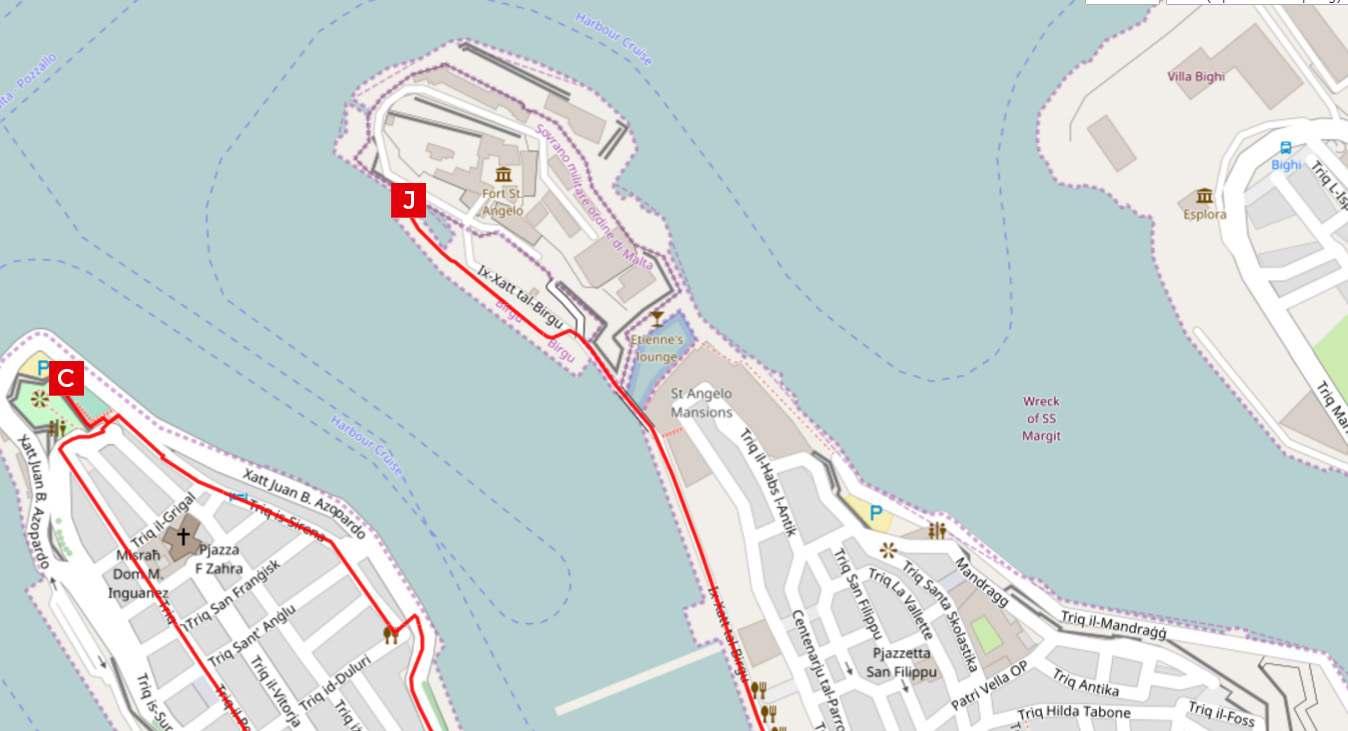

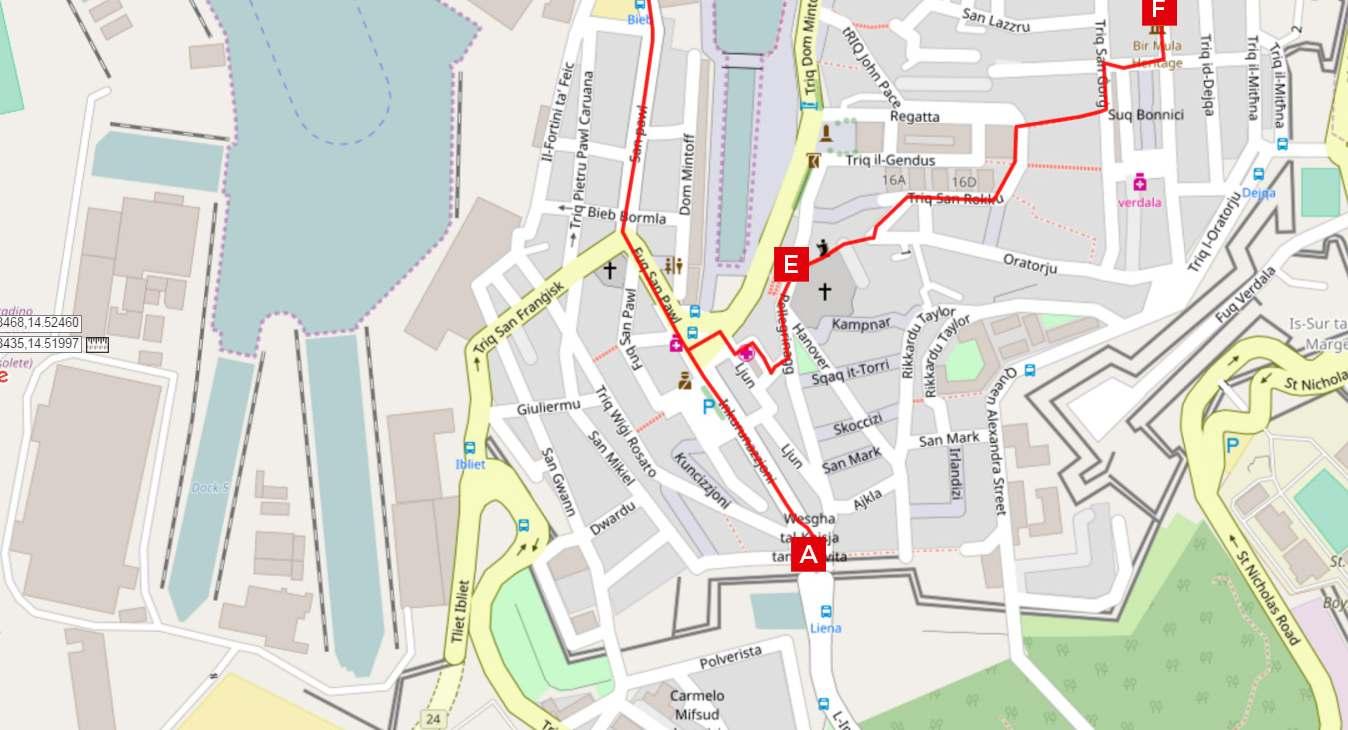
© travual.com | Buy the complete guide on shop.themediabay.be/en 28
DAY 3 - THE LONG WAY ROUND TO SIGGIEWI
• Distance: 32 km
• Starting Point: Hypogeum
• Finishing Point: Siġġiewi
Today, on Day Three of your Malta Tour, you will venture much further than you have done so far and begin to explore some of the wider island. This drive will not only take you round the southern portion of the island but will also take you back in time, to discover some of the best known and spectacular of Malta's historic sites and will also allow you to delve deep into some of Malta's natural wonders. We begin the tour at the Hypogeum, not far from the Three Cities and Valletta.

Ħal Saflieni Hypogeum is a huge subterranean structure that dates from 4000 – 2500 BC. Cyclopean rigging was used by the ancient people who excavated it to lift huge blocks of coralline limestone. It has been surmised that this was originally a sanctuary before it became a necropolis in prehistoric times. This underground cemetery was discovered in 1902. It was found to have contained the remains of around 7,000 people. The site contained not only architectural marvels but also a range of interesting archaeological artefacts that have shed some light on the lives of people of the period.
Ħal Saflieni Hypogeum, Triq Ic Cimiterju, Raħal Ġdid // GPS: 35.86957°N, 14.50688°E // See website for opening hours // Paid entry. Note that booking well ahead of time is advisable // http://heritagemalta.org/museums-sites/halsaflieni-hypogeum
Head north on Triq Ħal Salfieni and then turn right onto Triq Ħal Tarxien. After 450 metres, turn left onto Triq It Tempji Neolitici and reach the neolithic temples. (If you wish, you could easily park and walk between these two sites.)
The Tarxien Temples consist of four megalithic structures built between 3600 and 2500 BC. The complex was again in use for a time between 2400 and 1500 BC. The temple structures differ in age and in their state of preservation. An elevated walkway was constructed here in 2012. It allows guests to view these remarkable remains from rather a unique viewpoint. These temples are part of the UNESCO World Heritage Site made up of six megalithic temples that are spread across the islands. The Tarxien Temples have, like other
© travual.com | Buy the complete guide on shop.themediabay.be/en 29
1 2
temples on the island, now been covered by large tent-like structures that protect this important archaeological site.
Tarxien Temples, Triq It Tempji Neolitici, Ħal Tarxien // GPS: 35.8692°N, 14.5119°E // See website for opening hours // Paid entry // http://heritagemalta.org/museums-sites/tarxien-temples

Take

© travual.com | Buy the complete guide on shop.themediabay.be/en 30
Neolithic Ornament at Tarxien Temples © Shutterstock
Triq Il Palma to Tal-Barrani and then continue on that road for 3.7 km until you reach Marsaxlokk.
Marsaxlokk is a picturesque fishing village that has a long and fascinating history and is well worth taking the time to explore. It was here that the first Phoenicians landed and created trading posts during the 9th century BC. During the Great Siege of Malta, the harbour was used by the Ottoman fleet as an anchorage for their vessels. Beautiful boats bobbing in the pretty harbour, a popular tourist market, and a proliferation of good seafood restaurants mean that this place has become something of a tourist Mecca. It can get rather busy here in peak season, especially during the big weekend market. While spending some time in Marsaxlokk, be sure to check out the market and get some of the local seafood. If you tire of the crowds, head out onto the peninsula to the south east of the harbour village to see the lighthouse and Fort Delimara and perhaps to take a dip at the quiet and unspoiled St Peter's pool.
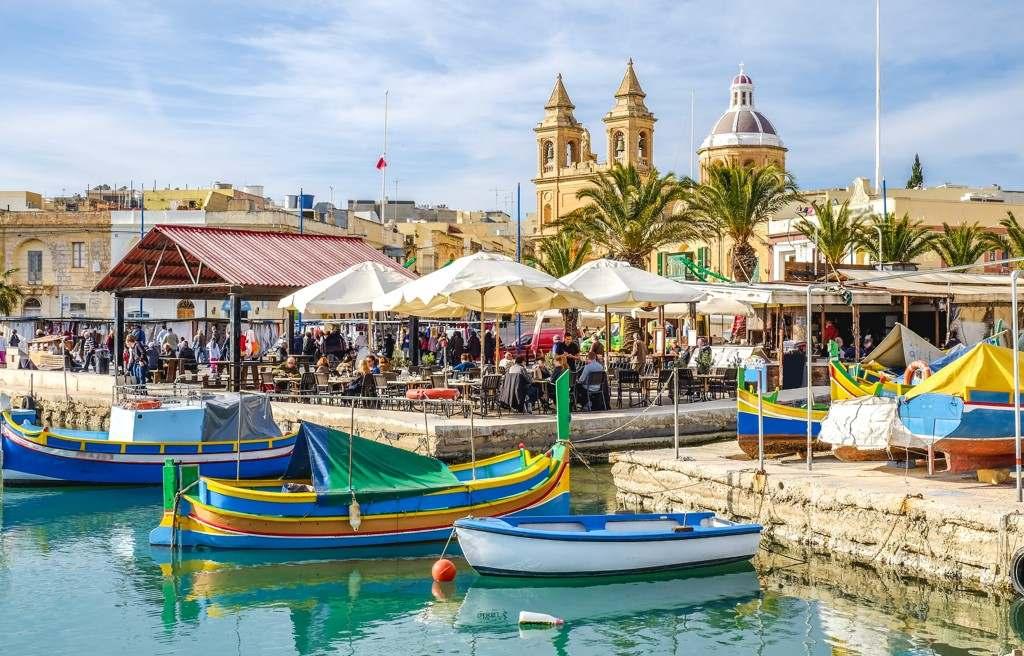

© travual.com | Buy the complete guide on shop.themediabay.be/en 31
Marsaxlokk © Shutterstock
3
St Lucian's Tower, also known as Fort Rohan or Fort St Lucian, is a large watchtower and polygonal fort that you cannot possibly miss as you make your way out of the harbour village of Marsaxlokk. The original tower on this site was built by the Order of St John in 1610 and 1611. It is the second of six Wignacourt Towers which were built around the island’s coast between 1610 and 1620 and one of four that still remain today. In around 1715, artillery batteries were built around three of the towers, and in the 1790s, Lucian Tower was strengthened and renamed Fort Rohan. It saw action during the French capture of the island and Maltese Rebellion that followed. In the 1870s, the British turned the existing fort into the polygonal fort that we see today.
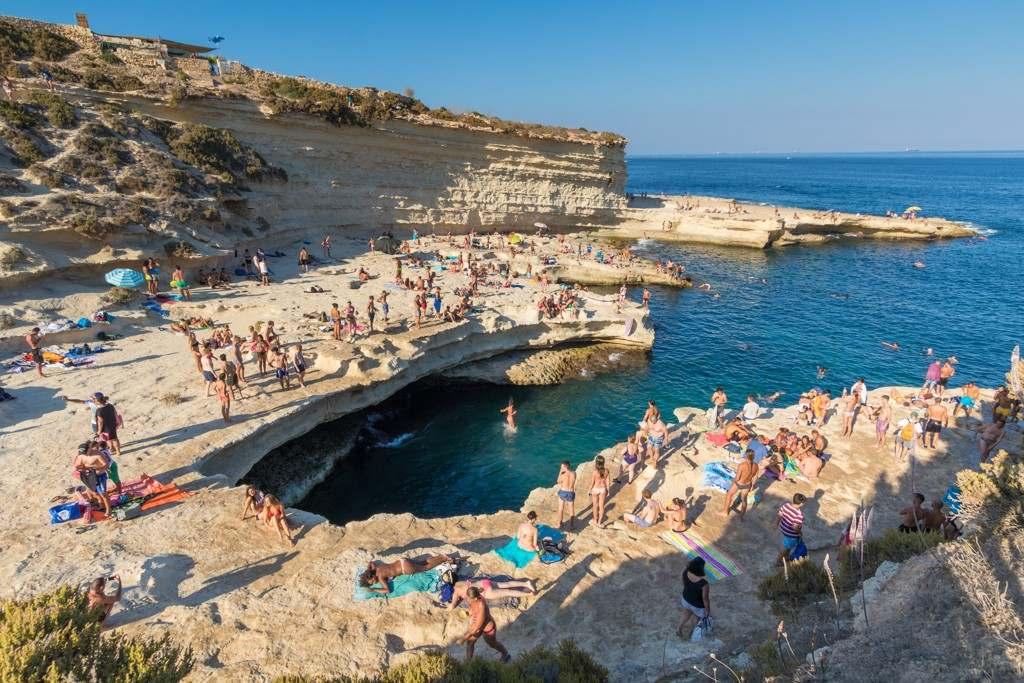

© travual.com | Buy the complete guide on shop.themediabay.be/en 32
St. Peterspool © Shutterstock
Exit Marsaxlokk harbour to the south on the Triq Tat Trunciera, and you will see St Lucian's Tower by the coast to your left.
4
St Lucian Fort, Triq Il-Qajjenza, Birżebbuġa // GPS: 35.83043°N, 14.54322°E // Interior not open to the public
The Għar Dalam Cave is a remarkable prehistoric site that was discovered in the second half of the 19th century. A series of archaeological excavations here have uncovered the bones of animals that are long since extinct, such as dwarf elephants, hippopotami, and a number of other interesting species, as well as human artefacts and remains that are the earliest evidence of human life on Malta. As well as viewing the cave, you may also see a Victorian-style display (one of only a handful left in Europe) and a beautiful native garden planted with indigenous plants.
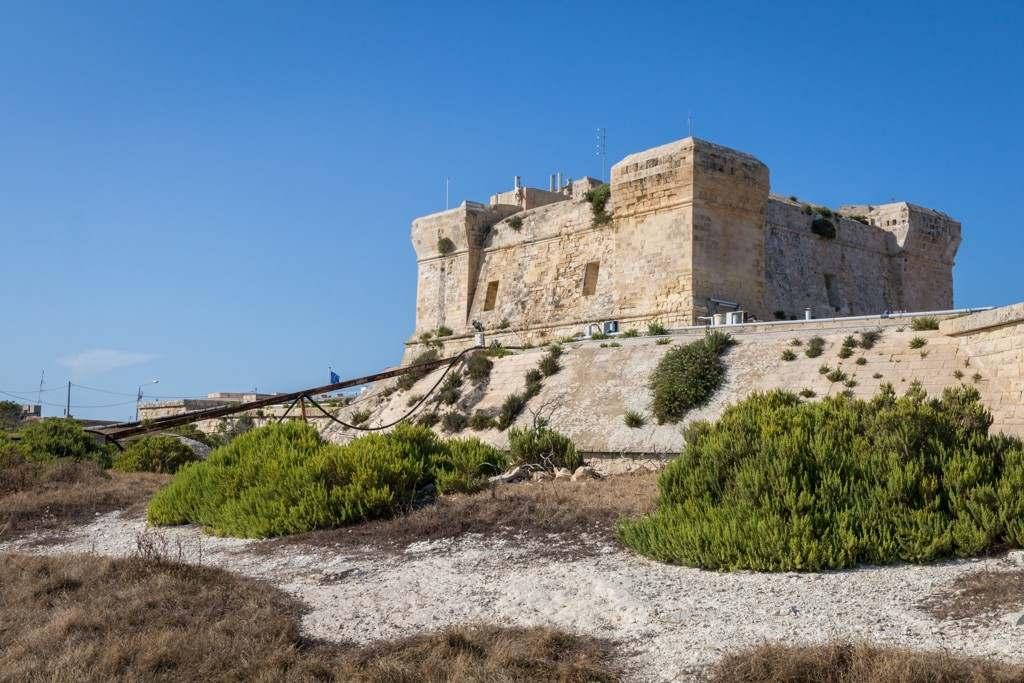
// http://heritagemalta.org/museums-sites/ghar-dalam

© travual.com | Buy the complete guide on shop.themediabay.be/en 33
St. Lucian’s Tower © Shutterstock
Head south-west on Triq Il-Qajjenza towards Triq L-Ghannejja and then, after around 1 km, turn left onto F.M. Ferretti. After a further 750 metres, turn right onto Triq Għar Dalam, and you will see your destination on the left after around 60 metres.
5
Għar Dalam Cave, Triq Ghar Dalam, Birżebbuġa, Malta // GPS: 35.8365°N, 14.5280°E// See website for opening hours / / Paid entry
Take Triq Għar Dalam south. This road turns slightly right and becomes Birżebbuġa. At the first roundabout, continue straight onto Triq Zarenu Dalli and at the second, take the first exit onto Triq Birżebbuġa. After 110 metres, turn right onto Triq Iz Zurrieq and then after half a kilometre, sharp right onto Triq Tal-Gebel. After just over 1.5 km, turn right into Triq Birżebbuġa and continue down and round through the harbour of Il-Brolli, Birżebbuġa. At the roundabout at the end of the harbour front, take the fourth exit onto Triq Ħal Far (You will pass by the Tal Bakkari Ruins on your left) and continue on that road as it becomes Triq Birżebbuġa and continue for a further 2.3 km. At the next roundabout, take the first exit and follow Triq Ħal Far. After almost 3 km, turn left onto Triq Wied IlFulija. This road will take you to one of the oldest parts of the village of Żurrieq.

Bubaqra is a charming, quiet location that is largely off the tourist map and, arguably, all the better for it. This is one of the Maltese towns that is a popular place for young couples choose to begin their life together. They like this place for its serenity, cooling breeze and fresh, uncrowded feel. It is a place that will also appeal to those who love to get off the beaten track and see a little real Maltese life. If you can, spend a little time just wandering around this pleasant area. Be sure to view the church at the heart of this historic, rural village, along with the tranquil churchyard and Bubaqra Tower on the edge of the area, a privately owned tower that was built for defensive purposes by the Order of St John in around 1579.
Once you have driven through the village and perhaps spent a little time there, take Triq San Iljun, Triq It-Torri and Triq In-Nigret to Triq Wied Babu, then take Triq Iż-Żurrieq to Is-Sajjieda in Qrendi. (Be sure to stop at the viewpoint for panoramic views of the Blue Wall en route.) From Is-Sajjieda you can take boat trips to one of Malta's most famous natural wonders—the Blue Grotto.
© travual.com | Buy the complete guide on shop.themediabay.be/en 34
6
The Blue Grotto is surely the most famous of all Malta's many highlights and is certainly one of its most popular tourist attractions. This series of sea caverns, between around sunrise and 1:00 p.m. each day, turn beautiful shades of blue in a natural phenomenon as the sun streams in and hits the water. Boat trips, scuba diving and snorkelling are all popular here, and you can find the perfect experience for you, whether you would rather stay on top of the water or venture under it.
Head back out of Is-Sajjieda the way you came in, along the Triq Iż-Żurrieq and then take a left turn after 550 metres. After just over a kilometre, turn left to reach another fascinating historical site and another of the best known attractions on the island.: Ħagar Qim.
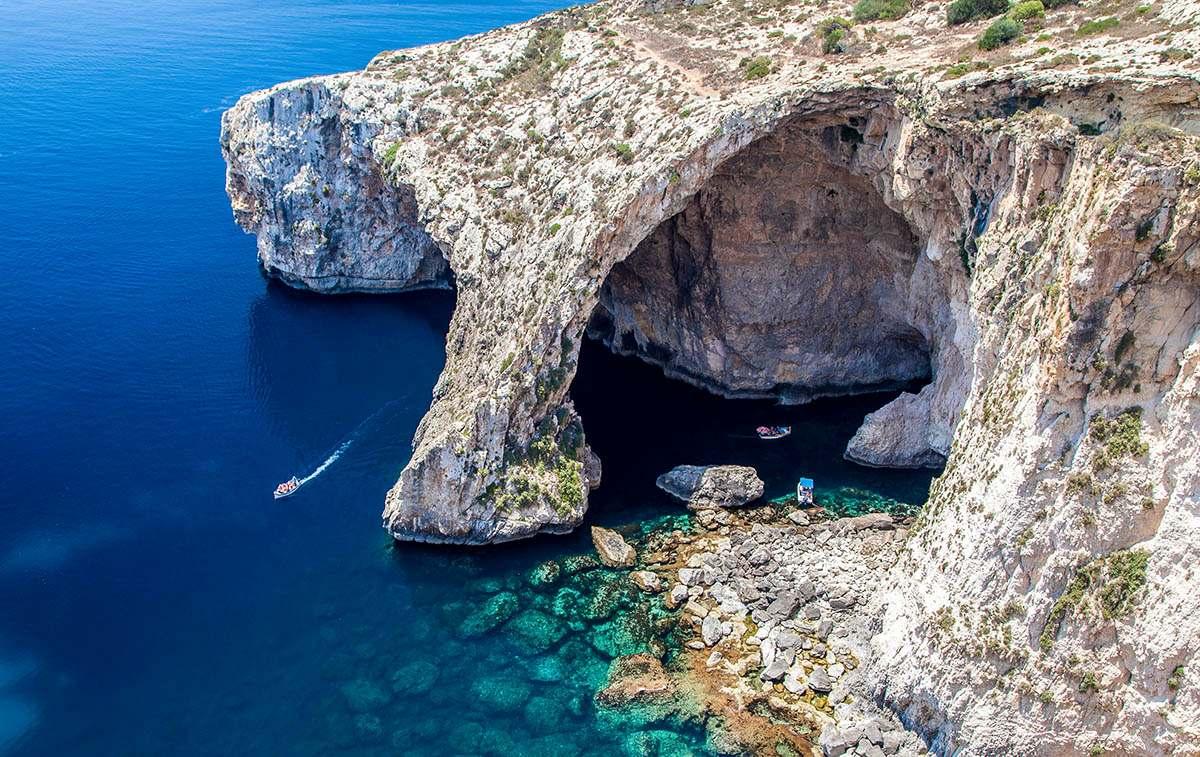

© travual.com | Buy the complete guide on shop.themediabay.be/en 35
The Blue Grotto © Shutterstock
Blue Grotto, Qrendi // GPS: 35.8198°N, 14.4518°E // See the official Blue Grotto website for boat timetable and other information // www.bluegrottomalta.com.mt
7
Ħagar Qim, an important temple complex, is another of the sites listed by UNESCO as part of the world heritage site, the Megalithic Temples of Malta. The site consists of a main temple and a range of additional megalithic structures close by. The main temple is thought to have been constructed between 3600 and 3200 BC, and the ruins to the north are said to be considerably older than that.
Approximately 500 metres’ walk from this temple complex you will find another, Mnajdra. This site dates from around the 4th millenium BC. It differs from the Ħagar Qim site in that the structures here are made from much harder coralline limestone rather than globigerina limestone. Here too, you will find a range of fascinating and ancient structures.
Ħagar Qim & Mnajdra, Triq Ħagar Qim, Il-Qrendi // GPS: 35.8277°N, 14.4418°E //See website for opening hours // Paid entry. The fee covers entry to Hagar Qim Temples, Mnajdra Temples and a Visitor Centre // http://heritagemalta.org/museums-sites/hagar-qim-temples/
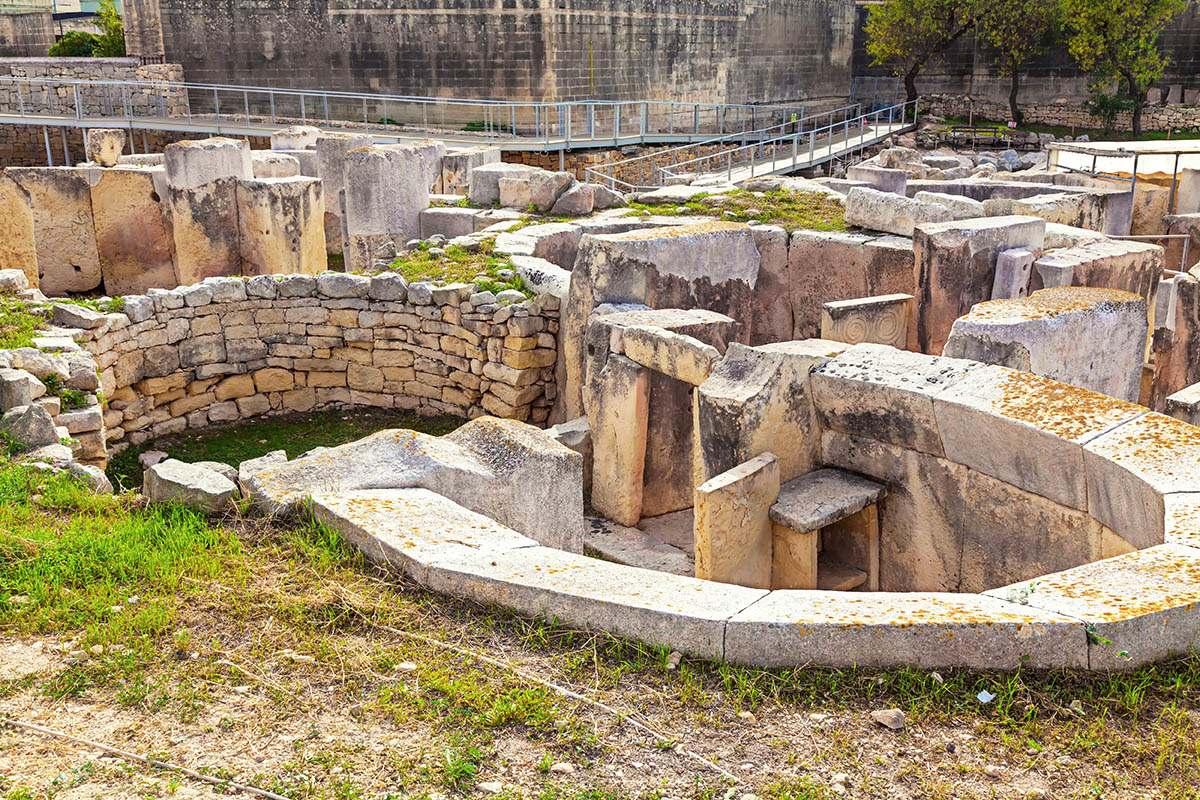
If you would like to go diving, the next location is one that you should certainly not miss out on. Ghar Lapsi Dive Site offers some of the best diving in these waters. To get there from Ħagar Qim, return to

© travual.com | Buy the complete guide on shop.themediabay.be/en 36
Ħagar Qim © Shutterstock
8
the main road from the site and turn left. Follow the road for 2.7 km. At the roundabout, take the first exit, keep left after 850 metres and then after a further 750 metres, turn right to reach the Ghar Lapsi Dive Site.

Ghar Lapsi is just a small hamlet and is rarely overcrowded, which is one of the reasons it is such an interesting place for a dive. In fact, diving or not, this tranquil place is a lovely spot to visit. This dive site offers a relaxing dive for experts and gentle options for those with less diving experience. There are plenty of scenic underwater features to explore, including a couple of caves and lots of tiny overhangs and reefs, even reefs that can be reached by complete novices. There are plenty of underwater options to tempt you to venture down the steep steps that lead to the shore.
Go back to the roundabout and take the first exit onto Triq Lapsi. After 1.8km, turn left onto Triq Illewza and then continue straight and you will reach the final destination on the day's tour, Siġġiewi.

© travual.com | Buy the complete guide on shop.themediabay.be/en 37
Ghar Lapsi © Shutterstock
9
Siġġiewi is a charming rural town with many interesting historic buildings to explore. If you have time, consider spending some time exploring here. A stroll through Siġġiewi's generally fairly quiet streets could be the perfect way to end your day. Look out for a number of buildings around the town that date from the days of the Knights Hospitaller, including the Armoury. Also in Siġġiewi you will find the Church of St Nicholas, whose festa is held in the last week of June. Niches dating to the middle of the 17th century are an interesting feature—not just an architectural feature but also a sign of religious devotion.
If you are touring from one overnight accommodation option to the next, you may wish to find something locally, otherwise it is easy to wend your way back to Valletta from here, past all the charming farmsteads with their stone walls. Either option will leave you well placed for the next day of this Malta driving tour.
Looking for a hotel in Valletta? Click here for special offers.

© travual.com | Buy the complete guide on shop.themediabay.be/en 38
10



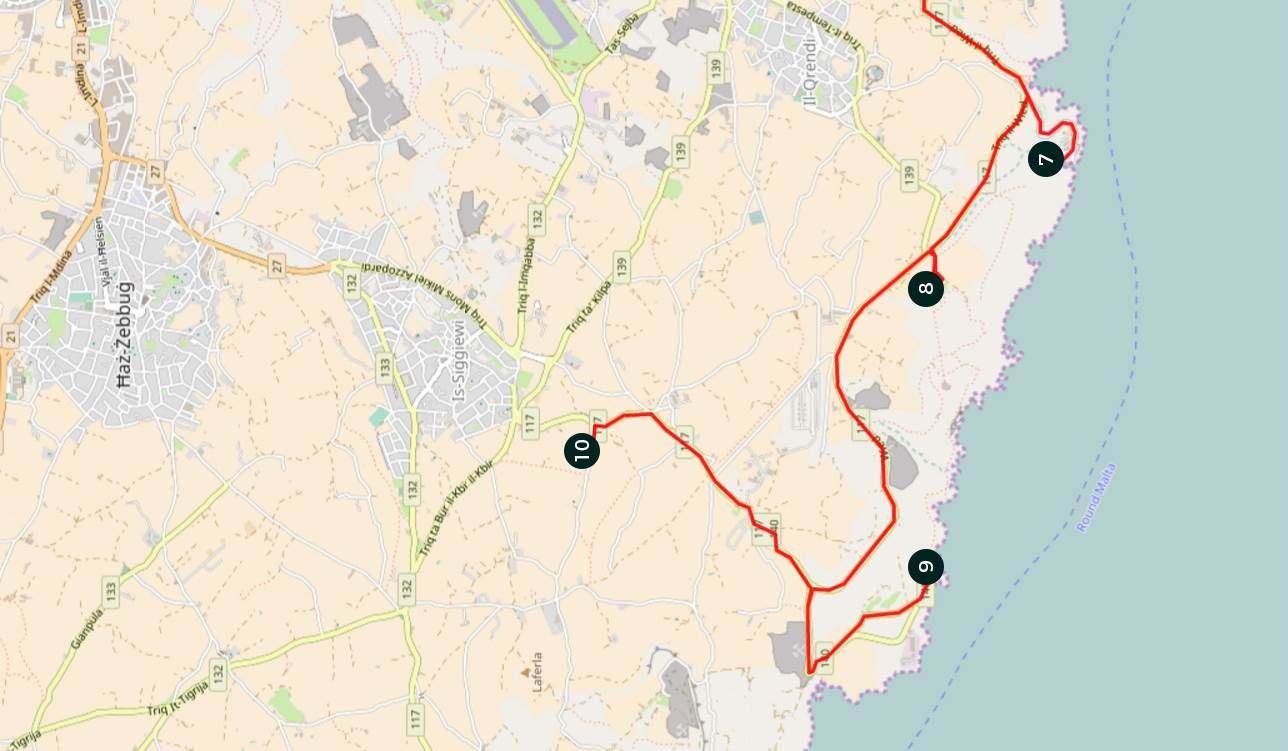
© travual.com | Buy the complete guide on shop.themediabay.be/en 39
This free travel guide contains the first 3 days of our road trip of Malta, Gozo & Comino.




Curious for more? Buy the complete travel guide (pdf – 106 pages A4, easy to print or read on tablet) for the price of 1 Stuffat-tal-Fenek (Maltese rabbit stew), and explore all 3 islands with more extra walking tours, lots of practical information and tips by locals.


© travual.com | Buy the complete guide on shop.themediabay.be/en 40
Buy now on http://shop.travual.com/en











































